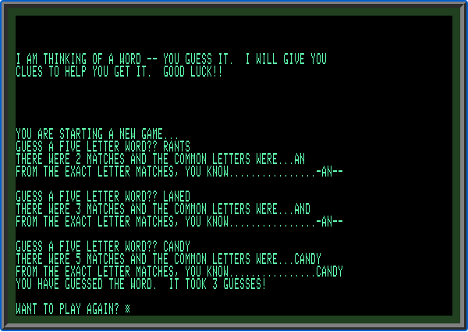While some have traced Wordle to Lingo, a game show that started in 1987, they’ve missed an earlier implementation: WORD was published in 101 Computer Games by Digital Equipment Corp. in 1973 and later in Creative Computing’s bestseller BASIC Computer Games, which went on to sell over a million copies. Unlike the 1955 boardgame Jotto, where players are told only how many letters are in the mystery word, WORD plays like Wordle, but with a text interface, providing information about what letters are in the mystery word and, of those, which letters are in the right place.
The game was written by Charles Reid of Lexington High School. You can play it in your browser! (David Ahl, the original editor of the two books, has graciously placed WORD and all of the other programs in the public domain.) Note that unlike Wordle, WORD doesn’t verify that a guess that you make is actually a word – in fact, given limits on memory size, the game only knows 12 different words!
WORD was one of the most well-developed BASIC guessing games in the book 101 Computer Games. (Though an implementation of Hangman had 50 words, ranging from gum to parasympathomimetic!)
But guessing games had a rather humbler origin. A guessing game has a structure that lends itself well to simple programs: the computer has hidden information, which the player must guess, with the computer typically providing a clue after each guess.
One of the oldest of these programs is actually named GUESS. Here’s a sample play:

Originally written by Walt Koetke, also of Lexington High School, in FOCAL (before the school switched to BASIC), the GUESS game inspired many others, presumably including WORD. When Dennis Allison in 1975 proposed that hobbyists “Build Your Own BASIC,” he mainly championed guessing games: “You would like to use it for homework, math recreations and games like NUMBER, STARS, TRAP, HURKLE, SNARK, BAGELS, …” All of these games are guessing games (and all but SNARK are in 101 BASIC Computer Games).
One of the other games GUESS inspired was HI-LO, which turns the guess into a dollar amount. Each time you guess correctly, you win that number as a jackpot and add it to your total winnings. When you fail to guess the jackpot, the game ends:

NUMBER is another jackpot-based guessing game, but you get one guess to guess a number from 1 to 5, then win or lose an amount. (This was written by a junior-high student, Ted Adametx, of Curtis Jr. High in Sudbury, Mass. Why are all these games from Massachusetts? Because of DEC’s promotion of BASIC to schools in its local market.) A sample play of NUMBER:

STARS, by Bob Albrecht of People’s Computer Company fame, is a game that shows you more asterisks the closer you are to the mystery number:

TRAP was suggested by a 10-year-old while playing GUESS and was first programmed by Steve Ullman. You guess two numbers and try to “trap” the mystery number:

BAGELS is a number guessing game where, instead of being told if you are high or low, you are told how many digits you got right. Think of it as Mastermind for 3-digit numbers, but with codewords for different states:
- Pico – one digit is right, but in the wrong position
- Fermi – one digit is right and in the right position
- Bagels – no digits are right
The original author might have been Lawrence Hall of UC Berkeley. Sample play:

LETTER replaces a mystery number with a mystery letter:

HURKLE extends numeric guesses to two dimensions and gives the game a story. “A shy hurkle is hiding on a 10 by 10 grid. Homebase is point 0,0 in the Southwest corner.” (HURKLE is probably based on SNARK.) Here’s a sample of HURKLE:

University of Pittsburgh students also used a grid, but now the search was for four mugwumps, at the same time, in MUGWMP:

As an example of combat-themed guessing games, here’s TARGET, a Star Trek game:

In fact, besides TARGET, there were a few riffs on combat-themed guessing games:
- Bombardment – Find four enemy platoons on a grid.
- Depth Charge – Captain a destroyer in its search for an enemy submarine.
- Gunner – Specify elevation and try to shoot an enemy in 5 shots of your field artillery.
- Salvo – The classic Battleship game, though the player needs to supply their own graph paper to play!
While guessing games worked well for Tiny BASIC implementations and early microcomputers, reversing these roles and having the computer guess what the human was thinking was much more difficult to implement, as it often required giving the computer extensive or trick knowledge. Some of these reverse guessing games:
- ANIMAL – One of the weakest games in 101 Computer Games. The computer could distinguish a fish from a bird, but that was it. It got smarter as the game was played, but in the days of cassette tapes, it wasn’t easy to save its expanded database, nor was there much RAM to store it anyway.
- SALVO – The computer and player take turns guessing, as in Battleship. The game ends when the computer or the human player sinks the other’s fleet.
- DIGITS – The player writes down the digits 0, 1, or 2 thirty times at random on a piece of paper, then the computer tries to guess them.
- NICOMA – A player thinks of a number from 1 to 100 and then the computer asks three questions and correctly guesses the number.
A screenshot from NICOMA:

Again, you can play each of these classic BASIC guessing games in your browser. Who knows, maybe among them you’ll find a different game than Wordle to rejuvenate for the smartphone age!



You must be logged in to post a comment.